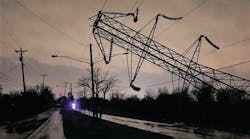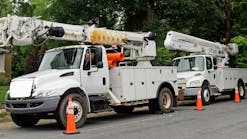A twister tore into middle Tennessee in the early morning hours of March 3, ripping down high-voltage transmission lines and tossing them into the Cumberland River. Nearby, winds roaring up to 165 mph dropped conductors onto a major interstate and knocked down transmission towers.
The EF-3 tornado damaged 38 structures and downed 17 power lines. In response, linemen for Tennessee Valley Authority (TVA) partnered with local power companies and contractors to restore power and rebuild infrastructure.
River Restoration
At 1 a.m., the line crew supervisors began getting calls about lines going down in different areas of the TVA’s service territory, which is divided into four areas. When the sun came up in Tennessee, the line crews narrowed the worst of the damage to the areas east and west of Nashville, which was in the path of the EF-3 tornado.
When TVA sent crews to assess the damage, the company quickly learned the extent of the destruction. By using unmanned aerial vehicles (UAVs), the crews were able to get a close-up shot of the fiber optic-wire, which was barely suspended over the river, to see if it could be salvaged for a few days before being replaced.
In addition, the crews discovered that three circuits and 27 cables had plunged into the river. In turn, TVA had to partner with marine police and the U.S. Army Corps of Engineers to block river access so the lines could be pulled out of the water.
Near the river, eight out of the nine transmission towers were laying down on the ground. With no sign of the ninth tower, the line crew followed a trail into the river bank and suspected what turned out to be the reality—the tornado ripped the tower off of its foundation and tossed it like a tin can into the river.
From the river’s surface, the transmission tower was not visible. TVA tried to slow the flow of the river by regulating the dams up and down so divers could locate the position of the fully submerged tower. To find and retrieve the tower, TVA opted to use sonar boats and contract with a salvage barge, which was a new work method for TVA.
Because the fuel supplies were getting low for industries located on the river, TVA was on the clock to clear the river and open it up to traffic as swiftly and safely as possible. By partnering with several players, TVA finally found the tower 40 ft off of the river bank. After removing it and the other transmission lines—one of which was owned by Nashville Electric Service—the boats were able to once again sail down the river.
Next, TVA could focus on restoration. The utility, however, faced another challenge—drilling holes in solid rock to install the replacement infrastructure. While TVA had access to specialized equipment, it had to run the diggers around the clock. To stay ahead, the company reached out to contractors for assistance. For example, TVA hired a blasting company to create some of the holes, and Service Electric and L.E. Myers also offered help with digging.
Once the structures were in place, TVA was able to develop a game plan and take action. TVA’s in-house helicopter pilots partnered with the company’s internal field workforce to string the pilot ropes across the river to pull new conductors for each circuit. By flying the pilot ropes across the river instead of transporting them by boat, the process took a couple of days instead of a few weeks.
Getting Substations Back Online
As one of TVA’s field managers was contending with the submerged tower and cables, another was awoken by a phone call about lines tripping east of Nashville. As the storm brewed, he asked his crew members to stay home. But once the tornado dissipated, the linemen came into assess damage.
At that time, seven substations were without power, and by the next day, five were already back online. The substations were between switches, and the technicians were able to swiftly sectionalize them.
Beyond the substations, the TVA eastern field team had to find a way to clear and rebuild two downed 500 kV lines and numerous towers. While the flying debris from the tornado did not impact the substations, it did hurl metal at the top of the towers.
TVA opted to replace three damaged 500 kV towers with similar structures, but it swapped out six damaged 161 kV towers with steel poles, which helped to speed restoration.
The strong winds also ripped down two of the circuits, which traveled across the interstate, along with two fiber-optic lines, which interfered with local cell service. Fortunately, the tornado narrowly missed four more circuits by about 1000 ft.
To coordinate the rebuilding process, TVA had several meetings about logistics with state agencies. The company did rolling road blocks on the interstate to pull in rope, but at the end of the day, opted to shut down the interstate and complete all the conductor pulls at one time. It took several days for TVA to install the new structures, but the linemen only had a maximum of six hours to pull the new conductor across the interstate. Through strong coordination and hard work, TVA was able to cut the traffic loose in just three-and-a-half hours.
Working Safely
TVA wrapped up restoration quickly and safely due to its in-house maintenance and construction crews of linemen. The company’s service territory is divided into four different areas, and TVA can pull equipment and resources from each area. Coupled with its internal helicopter team consisting of experienced linemen, and the field workforce can pull together quickly to get the job done in the wake of even the most severe storms.
TVA’s seasoned group of veteran linemen, who were experienced with storm restoration and knew the system inside and out, worked alongside new apprentices on the storm response. As they rebuilt the infrastructure, they took the apprentices under their wings to ensure their safety and teach them skills in the field. For example, they made sure they were aware of the danger of stored energy with the large towers.
At the peak of the recent tornado restoration, TVA had 170 employees from the line group who joined forces to clear and rebuild 17 lines and 38 structures. In addition, contractors removed downed trees and installed construction mats to allow the line crews to access the sites with storm damage and get their work done in the specified time span.
To keep the crews safe in the field, TVA conducted pre-job briefings every morning to outline the daily objectives and review hazards like downed wires. The supervisors, who all had experience working other types of storms in the Tennessee Valley, also kept in constant communication with each other and with their own crews about the work being done.
While TVA has encountered tornadoes in its service territory before, the recent twister caused unprecedented challenges for the linemen in the field. Beyond the sheer magnitude of the tornado, it was the first time in recent history that a twister hit a Tennessee metropolitan area like Nashville. As a result, the highways and interstates were jam-packed with onlookers, and TVA had to partner with is internal and city police departments to safeguard the public and crews. The security teams cleared the way so the linemen could transport materials and get their work done.
As of late March, TVA had all of its infrastructure rebuilt except for one structure by the river. On the tail end of the storm recovery, TVA had to deal with the social distancing challenges of the COVID-19 pandemic.
Like other utilities, TVA worked to lessen the crews’ exposure to the public. Trying to find ways to enforce social distancing guidelines in the field, however, proved to be more challenging. In response, TVA tried to break up the crews and assign them specific tasks. To mitigate their exposure, TVA also required them to wash their hands frequently and keep their work spaces and trucks clean and sanitized during the restoration process. As the pandemic continued to evolve, TVA kept the safety of the linemen in mind.
By focusing on restoring power not only quickly, but safely, TVA was able to get the power back on and help the Tennessee Valley on its path to recovery following the Tennessee twister.
Editor's Note: To see a UAV video of the damage near the Cumberland River, visit www.tdworld.com/electric-utility-operations.






